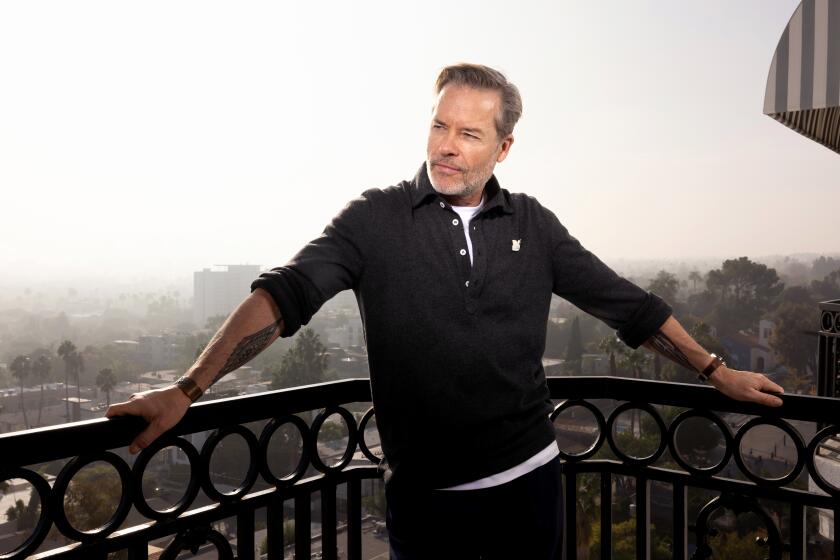Andrew Jarecki’s ‘The Jinx’ marks documentaries’ big shift in real time
- Share via
With its shocking killings, stylized reenactments and real-world consequences, “The Jinx: The Life and Deaths of Robert Durst” comes in a long line of true-crime documentaries that began more than a quarter-century ago with Errol Morris’ “The Thin Blue Line.”
But “The Jinx”--Andrew Jarecki’s HBO docu-series about an infamous murder suspect--has entered an environment much changed from that of Morris’ landmark 1988 work about the shooting of a Texas police officer.
As “The Jinx” played out in homes over the past six weeks, reactions rattled through social media immediately after episodes aired. And the finale on Sunday came the same weekend that Durst was arrested in New Orleans in connection with the death of Susan Berman, offering an unusual — and unusually fast — convergence of filmed entertainment and real life.
“It’s a very different world now,” Morris said by phone Tuesday. “When I made ‘The Thin Blue Line,’ we didn’t even know if we would get distribution. And then even when it came out, we played in theaters for months.”
Legal ramifications unfolded at a slower rate too. Morris’ subject, death row inmate Randall Adams, wasn’t exonerated until about a year after the film’s release.
“There were people signing petitions in front of movie theaters,” said Morris, who said he has not yet watched “The Jinx.” “It was very prolonged.”
Today, quick reactions on social media can create a national conversation. They help documentary filmmaking enter the culture faster than ever, and in turn are spurring directors to explore stories with a new urgency. “Documentary is making a comeback with digital media. ... It’s a new game,” said Duquesne University communications professor Garnet Butchart.
Those insta-conversations can make documentaries more relevant than ever. They can also mean that sensitive topics are evaluated with gladiatorial enthusiasm or even a rush to judgment.
These kinds of emotions seem to come up more often in the case of true crime stories, which capture our attention more than most nonfiction tales.
Documentaries have come a long way from the observational movies of the likes of Frederick Wiseman in the 1960s, who chronicled processes in public institutions with movies such as “High School” and “Post Office,” or with the cinema verite of filmmakers such as Albert and David Maysles.
The form has flowered and mutated in numerous ways. A spate of first-person documentaries would take root in the latter part of the 20th century, as Michael Moore, who came on the scene in 1989 with anti-General Motors story”Roger & Me,” would go on to make gun-control doc “Bowling for Columbine” and Iraq-war tale “Fahrenheit 9/11” in the early 2000’s. Morgan Spurlock made a name for himself at that time with his McDonald’s-centric participatory doc “Super Size Me.”
Meanwhile, filmmakers such as Steve James have been focusing on personalities; James made last year’s Roger Ebert biography “Life Itself” and helped kick off the unknown-hero genre with 1994 basketball tale “Hoop Dreams.” And issue-driven films have found a foothold too; recent examples include Robert Kenner’s “Food, Inc.,” Gabriela Cowperthwaite’s animal-rights tale “Blackfish” and this year’s Oscar winner “Citizenfour.”
True crime, however, has remained a favorite throughout.
Morris broke new ground with “Thin Blue Line,” which through careful investigation and reenactments (and a notable Philip Glass score), showed that Adams was wrongly jailed and that the prosecution’s witness, David Ray Harris, had committed the crime.
The movie “had a tremendous, unsettling effect on documentary in its moment,” said Jonathan Kahana, an associate professor of film and digital studies at UC Santa Cruz. “It brought speculation, doubt, confusion, mystery and suspense” into the modern form and has become “a model that everyone has been trying to emulate or imitate since.”
Eight years later, Joe Berlinger and Bruce Sinofsky made “Paradise Lost,” the first of what would turn out to be three movies from Berlinger about the young Arkansas men accused of brutal slayings known as the West Memphis Three. The movies carefully unraveled the prosecution’s case and helped turn attention to the trio’s plight. In 2011, they were released from prison.
And in 2004 the French filmmaker Jean-Xavier de Lestrade made the docu-series “The Staircase,” examining the twists and turns in the case of novelist Michael Peterson, who was accused of murdering his wife.
Other movies of late have also focused on crimes, including Nick Broomfield’s recent “Tales of the Grim Sleeper,” about the Southland serial killer Lonnie Franklin.
The appeal of the true-crime genre is not hard to understand: It combines a life more heightened than our own with the added hook of a mystery.
“There’s something very escapist about ‘The Jinx’ and about true-crime movies in general,” said documentary expert Thom Powers, who programs nonfiction films at a half-dozen festivals, including the Toronto International Film Festival. “Movies about crimes where a lot of people are affected, like Charles Ferguson’s financial meltdown movie ‘Inside Job,’ don’t seem to stir as much excitement.”
But Powers believes our motivations aren’t entirely salacious.
“The escapism in true crime is intertwined with a craving for justice,” he said. “Most of us see injustice in the workplace or our everyday lives that nobody does anything about, and movies like this bring us a sense of satisfaction.”
There may be an even more uncomfortable connection with the films, according to “The Jinx” director Jarecki.
“We’re all very narcissistic. We want to watch ourselves and imagine ourselves in situations where we’d handle them differently,” the director said in a recent interview with The Times. “I can climb in with Bob, and I can be part of his explanation and allow him the freedom to really tell his story ... you find you have more in common with him than you think.”
Interest in true crime is cresting in tandem with the popularity of serialized content, whose distinct chapters lend themselves neatly to the genre. Jarecki initially intended “The Jinx” as a feature-length documentary before making the deal for a multipart tale with HBO. The marriage of true crime and episodic content also spurred the phenomenon of “Serial,” public-radio reporter Sarah Koenig’s breakout podcast about the 1999 killing of a Baltimore high school student.
Powers says he is considering including more serial content at upcoming fests, including Toronto. Morris, meanwhile, is set to begin shooting a six-part docuseries for Netflix; he said more details would soon be forthcoming.
Although true crime stories have been good for viewership, its emergence has also come with pitfalls.
These tales necessitate that cuts be made, context reduced and emotions played upon. Even a nonfiction piece made with noble intentions is still fundamentally a piece of entertainment. And a piece of entertainment isn’t always a very good indicator of the truth.
“Paradise” director Berlinger said he has struggled with this issue.
“There is a fine line between investigation and exploitation, and a fine line between journalistic balance and trial by television that we all have to be of aware of and we all have to discuss,” he told The Times on Sunday after Durst’s arrest.
“There is a murky, moral gray zone of what is objective reporting versus what’s good for ratings and entertainment value,” he added. “Selective withholding of information for the right dramatic moment, stylized re-creations of painful events for the participants, putting ourselves on camera as the crusading, investigative reporter — all of these things chip away at the sanctity of the journalism.”
Morris offers a more succinct word of caution.
“I always feel,” he said, “like you should draw a distinction between making a true-crime story and investigating a crime.”
Times staff writers Meredith Blake and Mark Olsen contributed to this report.
More to Read
Only good movies
Get the Indie Focus newsletter, Mark Olsen's weekly guide to the world of cinema.
You may occasionally receive promotional content from the Los Angeles Times.












